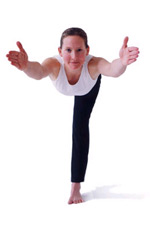
Exercise Videos
Exercise videos Home
Aerobics & Workout
Aquatics
Baby Boomer Fitness
Budokon
Dance to Fitness
Fitness Tools & Accessories
Jump Roping
Karate
Kick Boxing Exercise
Kids Dance & Exercise (& Sports!)
Pilates Mat Work
Prenatal Exercise
Recovery/Limited Mobility
Seniors' Dance & Exercise
Spinning
Stability/Fitness Ball
Workouts
Step Aerobics
Stretching & Warm up
Tai Chi/Qigong
Tone & Firm
Treadmill
Walking
Weight Training
Yoga
Instructors/Series
Denise Austin
The Firm
Cathe Friedrich
Gilad
Patrick Goudeau
Christy Lane
Lotte Berk Method
The Method
Leslie Sansone
Richard Simmons
Tae Bo
Urban Rebounding
System
Aerobics & Workouts
There are various types of aerobic exercise. In general, aerobic exercise is one that is performed at a moderately high level of intensity over a long period of time. For example, running a long distance at a moderate pace is an aerobic exercise, but sprinting is not.
Aerobic exercise confers many health benefits. It burns calories very effectively and, if performed regularly, can also increase the basal metabolic rate, both of which aid in weight loss. This form of exercise was first promoted by Dr. Kenneth H. Cooper in the 1960s, as a type of training designed to strengthen the heart and the lungs. When test subjects participated in regular, vigorous aerobic exercise, they gained a number of health benefits, which he collectively called the aerobic 'Training Effect'. These benefits include:
* Strengthening the muscles involved in respiration, to facilitate the flow of air in and out of the lungs.
* Strengthening the heart muscle, to improve its pumping efficiency and reduce the resting heart rate.
* Toning muscles throughout the body, which can improve overall circulation and reduce blood pressure.
* Increasing the total number of red blood cells in the body, to facilitate transport of oxygen throughout the body.
Regular, vigorous aerobic activity can, therefore, reduce the risk of death due to cardiovascular problems. In addition, high-impact aerobic activities (such as jogging or jumping rope) can stimulate bone growth, and reduce the risk of osteoporosis for both women and men.
